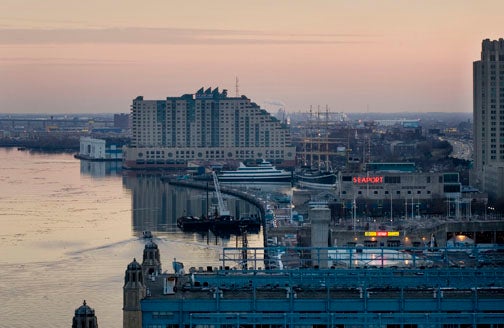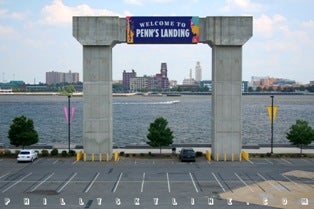Waiting for waterfront manager

Nov. 3
By Alan Jaffe
For PlanPhilly
The first item on the agenda when the Action Plan for the Central Delaware was unveiled in June: “Appoint an open, accountable, effective waterfront manager.”
Mayor Michael Nutter applauded the proposal and offered his full support to the idea of reforming — in fact, replacing — the Penn’s Landing Corporation. He pledged to announce a new board to lead the waterfront’s redevelopment within 30 days of the public gathering.
Three months after that deadline, Philadelphia is still waiting for the new board to be named.
Senior administration officials acknowledge the delay but say action toward that end has begun.
Andy Altman, the new deputy mayor for commerce and planning, says the city has been working on the composition and role of the board since Nutter made his promise, meeting with Council and state representatives, “getting organized” and tending to “a lot of technical work to get ready” over the summer and early fall. It’s just that a few things have gotten in the way of the process: a budget crisis, the violent deaths of several police officers, and the continuing debate over where the casinos will end up.
Altman is optimistic that the new Delaware Waterfront Corporation, as the mayor renamed the entity, will be in operation shortly. “I can’t say 15 days or 30 days, but we’re trying to get it done soon.”

Past Mistakes
The Penn’s Landing Corporation was created in 1970 as a non-profit, quasi-public organization that would manage publicly owned land on the Central Delaware from Spring Garden Street to Reed Street. Its goals were to serve as a catalyst for development in the district and to program year-round events for residents and tourists. The members of the board of directors were made up of at least 11 elected officials and members of the sitting administration and nine representatives from the private sector chosen by the board.
But critics say the corporation wasn’t even “quasi” public. Meetings and decisions were held behind closed doors, without any citizen input. Even the names of the entire board were not publicized.
Within that secretive climate, the organization developed a reputation for patronage and waterfront projects were stymied by scandal. Former Councilman Leland Beloff was convicted in 1987 and sentenced to 10 years in prison for conspiring with local mob boss Nicodemo Scarfo of trying to extort $1 million from developer Willard Rouse 3rd in exchange for legislation that would permit a $70 million project on the river.
In 2006, Leonard Ross, who had been appointed by Mayor Street to chair the Penn’s Landing Corp. developer-selection committee, was convicted of fraud and sentenced to 30 months in prison for using his position to pressure candidates to contribute to the mayor’s re-election campaign.
Besides the decades of silence and corruption, the corporation never realized its goal of transforming the waterfront. Sweeping, expensive projects to redevelop Penn’s Landing fell through. And the smaller projects that were finished reflected a piecemeal approach to the waterfront.
“I think the mission of the Penn’s Landing Corporation from the start has been development-focused, so what is now 2.2 miles of public waterfront has largely been handed over to private developers on a long-term lease,” said Harris Steinberg, executive director of PennPraxis, the primary author of the Civic Vision and Action Plan for the Central Delaware. What could have been public space – trails and piers and parks – has been developed “without any overarching plan or sense of connectivity to the city as a whole,” Steinberg said.
“They looked at parcels on an individual basis. They looked for developers for individual parcels. But there wasn’t any sense of legacy, common good, or creating public spaces that would leverage a quality urban design.
“They seemed to be just deal-making.”

A New Mission
The recommendation of the Action Plan is that the new waterfront manager transform from being a development corporation to one that designs, implements and manages public space, Steinberg said.
“Which means the old model of trying to find a master developer for sites like Penn’s Landing and Festival Pier is not the model that we’re recommending. [The Action Plan] is really one that helps to create and manage open spaces that then provide a catalyst for development that it would support.”
Altman and the city administration support the revised mission.
The new board will have a broad mandate, Altman said, expanding its geographical jurisdiction to include the Central Delaware from Oregon to Allegheny Avenues.
And its role will change, in accordance with the Action Plan recommendations. “We’re taking the PennPraxis vision very seriously,” Altman said. “We want to have a single point of contact to manage the activity on the waterfront,” from creating open space, to encouraging appropriate development, to building the needed infrastructure. The organization will have the capacity “to manage a diversity of activities,” he said.
Among the first goals of the new board will be the creation of space for “the public realm.” There are several piers owned by the city that could be revitalized for recreation, much like New York’s Hudson Park, Altman said. “The focus will be on creating great public spaces.”
“This kind of job is often a multi-year, often multi-generational effort,” he said. “It will be solely dedicated to governance of the waterfront.”
“We’ll see a real change. But it won’t happen overnight,” said Altman, who ran the waterfront corporation in Washington D.C., and spent three years working on its master plan. “It’s a great thing for this administration that PennPraxis has drawn this great plan. Our challenge is to implement it.”
Quality, Not Quantity
From its current size of 26 slots for members, including nine appointed by the mayor, the board should be slashed to seven or eight, according to Steinberg. “The goal is to change the board from being a political ex-officio board to a lean, corporate board.”
Part of the problem with the existing corporation has been its cumbersome number. The other factors required in the process of reforming the board are “the caliber of people,” a new mission, and the end of “political horsetrading,” he said. “If it has a refocused mission, if it has a board that is above politics, we believe it can move quickly to implement” the other proposals of the Action Plan. “We also believe it can regain the public trust, which is critical. Right now, the civic associations of the river wards, as well as the public at large, view Penn’s Landing as a lost cause.”
For years, Philadelphians have been shut out of the decisions on what would happen on their eastern waterfront. “So the role of the public in the future of Penn’s Landing is absolutely critical. To maintain the public trust, things must be done in a transparent fashion. This has got to be not about politics, but about achieving public good, because these are public properties. The public owns them. It’s all public funds that are used or leveraged, and regaining the public trust is critical.
“So, it’s not the size [of the board] that matters, or that we think a smaller size will be able to act more expeditiously,” Steinberg said.
It’s who and what they do, and how they do it.
The composition of the board should include members with competencies in law, real estate, development, and design, Steinberg said. The authors of the Action Plan have also called for the inclusion of community leaders. “We haven’t specifically made recommendations [on which groups] other than the Central Delaware Advisory Group,” the organization that grew out of the 15 civic associations that participated in the drafting of the Civic Vision for the Central Delaware.
Altman agrees and echoes those recommendations for members. “We’re looking for someone from the field of finance, because one of the biggest challenges will be how to finance the public improvements that are needed. We also want people from real estate, because of the complicated real estate issues there. We’re going to want some business leadership to make it a reality. We want a community representative, and someone from the design and environmental professions.
“This board has to have a high profile, it has to signal change, and we’re looking for people that can bring that stature and leadership to the board,” Altman said. “They should have a good network of connections.”
The proposed change for the waterfront will be a “huge project, and it’s going to be complicated, especially in this economic climate. It will take a lot of creativity” on the part of the new board,” he said.
Will Altman, with his experience in waterfront management, be on the board? “I hope to.”
Steinberg, who refuses to name anyone else he’d specifically recommend for the board, calls Altman “a natural.”
The recommendations to the mayor have emphasized that the board must “be of the highest civic and ethical caliber,” Steinberg said. “It has been a bastion of political patronage and payback over time. If the mayor is serious about a reform message, the folks he appoints should be of the absolute highest caliber. Anyone who is appointed should have national or international credentials in corporate governance, development, real estate law, planning and design. And that should be the standards that they’re held to.”
A key step in the process is “to convene the old board to kill the board to create the new board,” Steinberg said.
The new members can then revise their mission, refine the bylaws of the board, and create a system “by which is can perpetuate itself in a transparent fashion” and transcend mayoral administrations.

Who Should Stay?
The recommendations for dissolving the Penn’s Landing Corporation distinguish between “governance and operation,” Steinberg noted.
Penn’s Landing, after all, has become home to July 4th week fireworks, winter ice skating, river tours and ship tours, concerts on Festival Pier, tall ship festivals, ice cream festivals, and a world of ethnic festivals – some 70 events each year. And the roadways, paths and medians near the Landing have been beautifully planted and maintained, with the help of the Pennsylvania Horticultural Society.
The programming and landscaping is credited to the Penn’s Landing Corporation operating staff, which has been led since 2004 by acting president Joe Brooks.
Brooks and his colleagues were at the unveiling of the Action Plan at the Independence Seaport Museum on June 26, an “unnerving experience” for the employee of the corporation since 1989. “We knew about the broad brushstrokes of the Action Plan, but we were hearing the details for the first time.”
It wasn’t as if Brooks, who supervises a staff of 150 full-time and seasonal workers, didn’t know about the problems and the criticisms of the Penn’s Landing Corporation.
“It was especially frustrating over the years for me because I’m out there, talking with people – and I was never one to hide or shy away from anything.”
When Dominic Sabatini retired from the president’s position in 2004, Brooks called for a more open, accountable waterfront agency. “But the board didn’t share that desire for openness that I had wanted.” In 2006, he drafted what he calls a “Sunshine Act manifesto” to the board, seeking open meetings, public notices and public participation at the meetings. “The board didn’t vote on it. I was smacked down,” Brooks said.
“I had wanted it because we were getting clobbered, and in certain instances rightly so, as a do-nothing, secretive Penn’s Landing Corporation. I wanted our doors open, I wanted the press to know, so we could break down those tired clichés about PLC, and to see how hard the staff worked.”
Brooks has been working on his own plans and proposals for the city since 2007, drafting a “transformative document” about what needs to be done with the corporation.
“We have a massive board of governors that is completely political in nature. Those folks who weren’t voted on were still a part of the elective process. Our document said that you have to change the paradigm on how you appoint members of the board. No longer could it be the lawyer who would get all the bond work. No longer the person who wrote the biggest check. Or the ward leader who was important to an elected official,” Brooks said. The board needs members with experience in design and architecture, hospitality, and grant-writing, and representation from the community. “Until then, we will always be a vehicle for elected officials, not a vehicle for bringing about renewal of the waterfront.” Brooks said.
Since June, Brooks has been in dialogue with the Commerce Department about the changes to come. “We haven’t received a specific time frame. My guesstimate is that this gets done sooner rather than later,” he said.
Brooks would very much like to keep his job. “This place has been a passion for me. I asked my wife to marry me at Penn’s Landing. I started here fresh out of college and worked my way up. The waterfront has been such a part of me … I have a desire to see through what I think I’ve had a key role in getting us to until this point. And I think I have something to bring to the table.”

Making It Happen
Whoever leads the new waterfront management entity, on the ground or in the boardroom, its new, reformed, refocused and expanded role will require more funding. The operating budget of the current Penn’s Landing Corporation is $8 million per year, mainly earned through leases and parking revenue.
Tax increment funding has been considered as a way to support the major infrastructure improvements of the Action Plan. “But with the market as it is, how useful a TIF is right now is questionable,” noted Steinberg. Other possibilities include transportation enhancement dollars from PennDot, assessing fees from a designed business improvement district, and casino revenue.
“There is also a potential to leverage federal dollars,” Steinberg said. “I know we are about to spend $700 billion to bail out Wall Street,” but Barack Obama has talked about creating a public works program that should include a project like the Central Delaware. “It’s a regional asset that, if done correctly – and might even include the redesign of I-95 — could be the kind of transformative investment in infrastructure that continues to keep Philadelphia a city of choice for the next economy,” he said.
“So we have a list of possible funding sources. I think the goal of the corporation now is to reorganize, look at the funds that they have, and see what they can leverage in terms of city dollars, private foundations and other sources to keep the momentum going until the market picks up.”
Philadelphia’s new waterfront manager can look north to the Hudson River Trust in New York City as a model. The trust raises $18 million a year and has already designed and implemented about five miles of trails, piers and public spaces, as well as private recreational facilities, Steinberg said. It acts partly like a special services district and functions as a waterfront manager.
“That’s an example of a city- and state-appointed board. It is a non-profit with extraordinary powers to define its mission, boundaries and membership.”
While Steinberg had expected Philadelphia to be a little further ahead in implementing the first stage of the Action Plan, the timing may help the new waterfront board.
“The benefit now with the market being slow, or stalled, is that the new corporation can take time to get on its feet, really come up with a revised mission agenda, start its outreach to the private sector, and form a foundation with the community.
“There’s a tremendous opportunity now to really get it right. The development pressures are much slower than they were even a year ago. Two years ago, when we started the process, there were 22 condominium towers planned. Even the fact that one of the casinos may be moving, and the other is talking about changing some plans, means that there is a lot of civic momentum towards implementing the Action Plan and the Vision.”
Contact the reporter at alanjaffe@mac.com.
WHYY is your source for fact-based, in-depth journalism and information. As a nonprofit organization, we rely on financial support from readers like you. Please give today.



